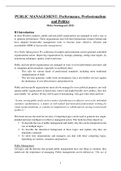Samenvatting
Samenvatting boek Noordegraaf 'Public Management'
- Vak
- Instelling
- Boek
Volledige samenvatting van het boek van Mirko Noordegraaf 'Public Management: Performance, Professionalism and Politics' in het Engels geschreven. Ik hoop dat je wat hebt aan deze samenvatting, succes met het tentamen!
[Meer zien]









